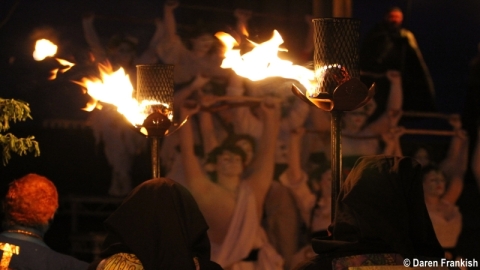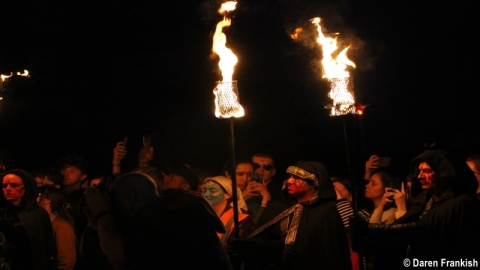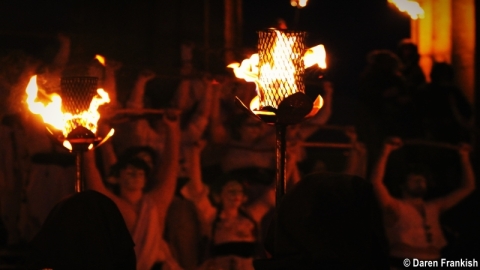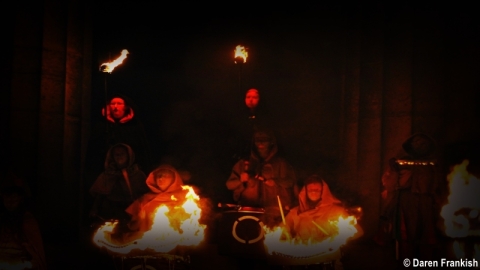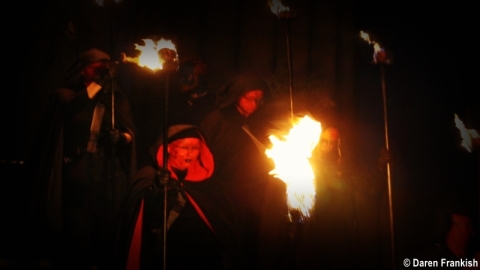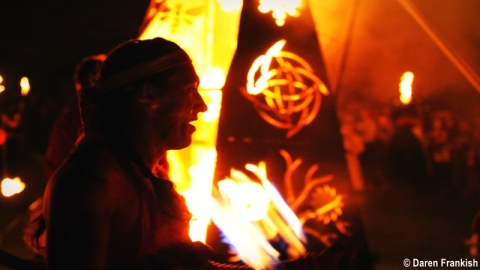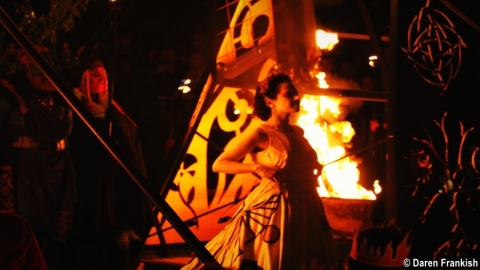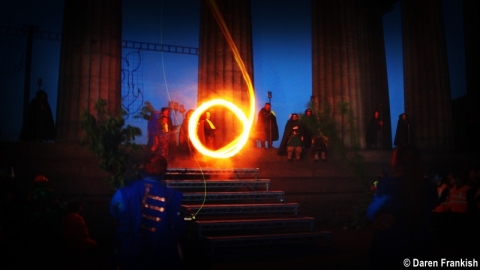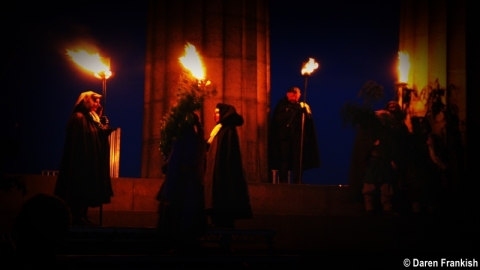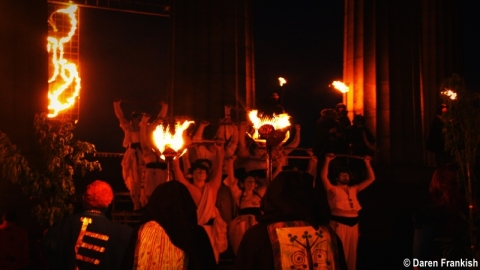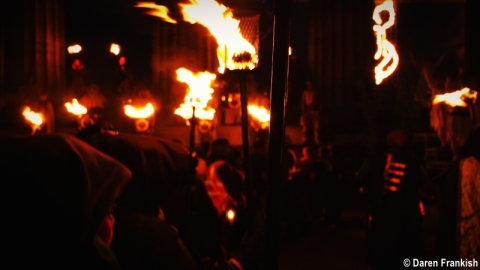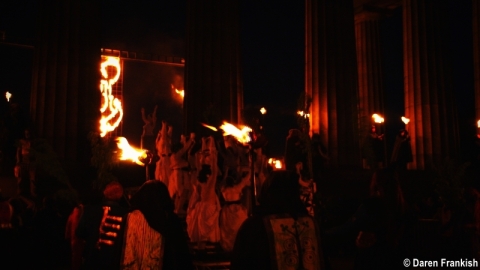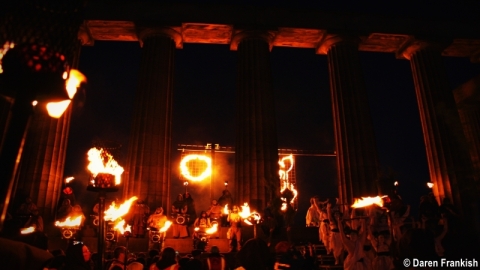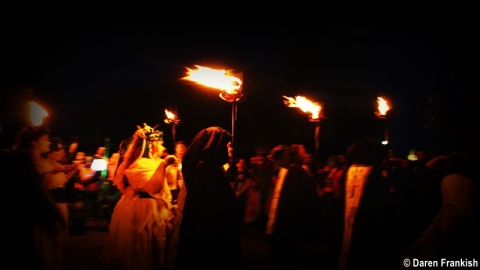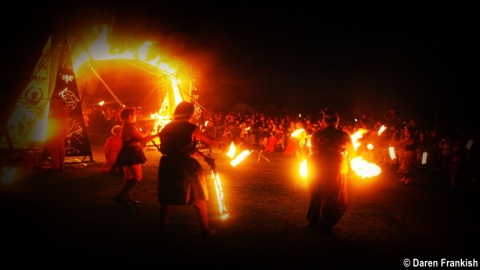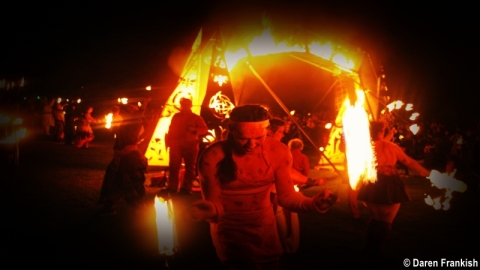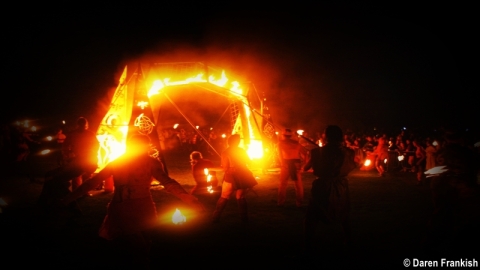News
Beltane Fire Festival 2025
Calton Hill, Edinburgh

Beltane Fire Festival (Source: © Daren Frankish)
USPA NEWS -
The Beltane Fire Festival in Edinburgh: A Celebration
The Beltane Fire Festival, held annually on April 30th in Edinburgh, celebrated the arrival of summer and the rebirth of the earth. Rooted in ancient Celtic traditions, this festival brought together hundreds of participants and thousands of spectators, transforming the Calton Hill into a vibrant spectacle of colour, fire, and music.
The Beltane Fire Festival, held annually on April 30th in Edinburgh, celebrated the arrival of summer and the rebirth of the earth. Rooted in ancient Celtic traditions, this festival brought together hundreds of participants and thousands of spectators, transforming the Calton Hill into a vibrant spectacle of colour, fire, and music.
As dusk fell on the night of the festival, the atmosphere thickened with anticipation. Fire performers illuminated the hillside, their flickering flames dancing against the backdrop of the city. Dressed in elaborate costumes, participants embodied various characters from Celtic mythology, including the May Queen and the Green Man, who represented fertility and the spirit of nature.
The procession began as a parade of drummers and dancers moved through the crowds, leading everyone in a celebratory journey. Those attending the festival engaged with the performers, experiencing the rich history and meaning behind the rituals. The central bonfire was ignited, symbolizing the return of the sun, and everyone gathered around to absorb its warmth, celebrating the life-giving energy of fire.
The procession began as a parade of drummers and dancers moved through the crowds, leading everyone in a celebratory journey. Those attending the festival engaged with the performers, experiencing the rich history and meaning behind the rituals. The central bonfire was ignited, symbolizing the return of the sun, and everyone gathered around to absorb its warmth, celebrating the life-giving energy of fire.
Throughout the night, performances included storytelling, dance, and music that paid homage to the changing seasons. The festival highlighted the connection between humanity and nature, reminding participants of the importance of rebirth, community, and the earth's cycles.
As dawn approached, the May Queen danced around the fire, signifying the fertility of the land and the promise of a bountiful harvest. With the first light of day breaking over the horizon, the festival culminated in a powerful celebration of life, unity, and the joys of spring.
As dawn approached, the May Queen danced around the fire, signifying the fertility of the land and the promise of a bountiful harvest. With the first light of day breaking over the horizon, the festival culminated in a powerful celebration of life, unity, and the joys of spring.
The Beltane Fire Festival not only created a magical experience for those in attendance but also fostered a deep appreciation for cultural heritage and the timeless rhythms of life, leaving lasting memories long after the flames had extinguished.
The Beltane Fire Festival is an ancient Celtic celebration that marks the arrival of summer, traditionally held on the night of April 30th to May 1st. In Edinburgh, Scotland, the Beltane Fire Festival has evolved into a vibrant and theatrical event that attracts thousands of participants and spectators annually.
The origins of Beltane date back to the pre-Christian Celtic festival of Bealtaine, which literally translates to "Bright Fire." It was celebrated across the Celtic lands to signify the beginning of summer and often involved lighting bonfires to boost fertility in cattle, crops, and people. The fires were lit on hilltops, and their smoke was believed to ward off evil spirits.
The festival also included various rituals, such as the procession of the May Queen and the May King, who symbolized fertility and the growth of new life. Communities would gather to celebrate with music, dancing, and feasting, reinforcing social bonds as they welcomed the arrival of warmer weather.
The origins of Beltane date back to the pre-Christian Celtic festival of Bealtaine, which literally translates to "Bright Fire." It was celebrated across the Celtic lands to signify the beginning of summer and often involved lighting bonfires to boost fertility in cattle, crops, and people. The fires were lit on hilltops, and their smoke was believed to ward off evil spirits.
The festival also included various rituals, such as the procession of the May Queen and the May King, who symbolized fertility and the growth of new life. Communities would gather to celebrate with music, dancing, and feasting, reinforcing social bonds as they welcomed the arrival of warmer weather.
The Beltane Fire Festival as it is recognized today has its roots in the late 20th century, specifically in 1988. A group of artists and performers sought to resurrect the ancient traditions associated with the festival as a response to the loss of cultural heritage and the increasing commercialization of other festivities. Under the auspices of the Beltane Fire Society, the event was revitalized and transformed into a community-driven project.
The first modern festival featured a handful of performers and local involvement, gradually growing in size and complexity over the years. Today, it is a major cultural event in Edinburgh, attracting an audience of around 12,000 people.
The Beltane Fire Festival is now celebrated with a spectacular night of performance art that combines ancient and contemporary traditions. The festival features a grand procession that begins at dusk, culminating on Calton Hill with the lighting of bonfires and a range of performances including music, dance, and visual displays.
Key elements of the celebration include the May Queen and the Green Man, representing the earth's fertility and renewal. Participants dress in elaborate costumes, adorned with natural materials, and engage in theatrical performances that narrate the seasonal changes, the battle between the forces of winter and summer, and the rebirth of nature.
Community involvement is a significant aspect of the festival, with local volunteers taking part in the organization and execution of the event, allowing for a sense of ownership and authenticity.
The Beltane Fire Festival emphasizes themes of renewal, community, and the connection to nature. It has become a platform for creativity and expression, highlighting the importance of cultural heritage while fostering a sense of belonging among participants and attendees.
Moreover, the festival serves as a reminder of the historical and cultural roots of the area, preserving traditions that might otherwise be forgotten. It continues to evolve, reflecting contemporary societal values while celebrating its ancient origins.
The Beltane Fire Festival in Edinburgh is a striking example of how ancient traditions can be rediscovered and revitalized in the modern context. By integrating art, community, and heritage, the festival not only honors the past but also celebrates the ongoing relationship between people and nature, heralding the arrival of summer with fire, festivity, and unity.
About this event click on the "More Information" link below.
Moreover, the festival serves as a reminder of the historical and cultural roots of the area, preserving traditions that might otherwise be forgotten. It continues to evolve, reflecting contemporary societal values while celebrating its ancient origins.
The Beltane Fire Festival in Edinburgh is a striking example of how ancient traditions can be rediscovered and revitalized in the modern context. By integrating art, community, and heritage, the festival not only honors the past but also celebrates the ongoing relationship between people and nature, heralding the arrival of summer with fire, festivity, and unity.
About this event click on the "More Information" link below.
more information: https://beltane.org/about-beltane/
Liability for this article lies with the author, who also holds the copyright. Editorial content from USPA may be quoted on other websites as long as the quote comprises no more than 5% of the entire text, is marked as such and the source is named (via hyperlink).


